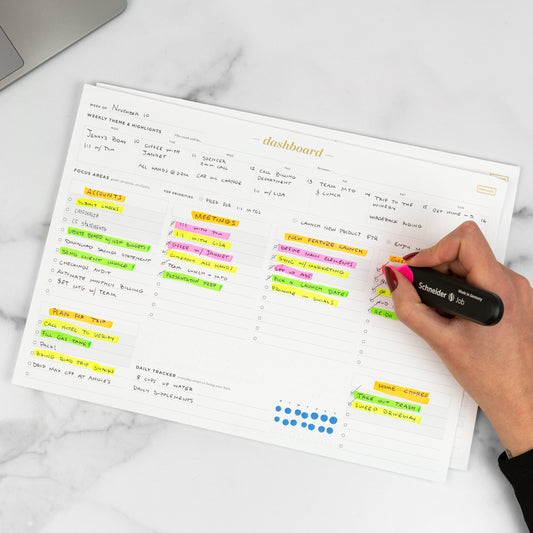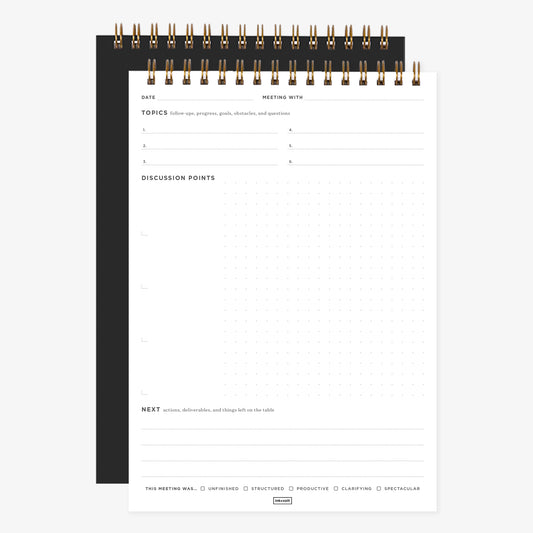When you write out your weekly to-do list, how do you decide what you should work on first?
Prioritizing starts from the very the beginning, trickling down and affecting every single thing you need to get done. The better you’re able to prioritize tasks, the more:
- Efficiently you’ll use your time
- Effectively you’ll work towards your goals
- Easily you’ll accomplish the most important work you have to do
As you prioritize your list, you have to not only put work items in a logical order, but you also have to estimate how long each task will take, so that you can see how much of your list you’ll be able to accomplish.
Most people overestimate how much they can do in a certain amount of time. The consequence? Stress, frustration, and feeling like you’re behind schedule when that’s not really the case. If you had estimated more realistically, you would set more achievable expectations.
It’s like creating a roadmap for yourself; you could wing it and hope for the best, but if you want results, invest the time and energy upfront to prepare a strategy.
Before you get whisked away by the most exciting task or lost in a maze of indecision about what to take on next, it’s time to become a pro at prioritizing your to-do list and budgeting your time.
Your to-do list – a list of ideas and tasks
Your to-do list is a fluid, ever changing list of things you need or want to get done. And we say “want” because sometimes you have great ideas you plan on carrying out, but something gets in the way. Maybe you run out of time and a deadline passes, or your plan for execution was unrealistic or didn’t have backing from another person whose input you needed.
So whether you’ve had an awesome brainstorming session and are overflowing with ideas, or struggled to get into a rhythm to generate the few ideas you have, where will you start? Once you have all your thoughts and ideas written down, how do you organize them?
Should you do what is most important first? Or maybe tackle the most urgent task? Or should you start out by doing something easy that you like to do?
Getting into the habit of strategizing will tell you a lot about yourself. Each time you work on your to-do list items, you have the chance to make smarter decisions than you did last time. How can you improve on your performance last week? What mistakes did you make in planning, and how can you correct them this time?
Getting the timing right
The planning fallacy. Psychologists Daniel Kahneman and Amos Tversky coined the phrase the planning fallacy, which Kahneman describes in his book “Thinking Fast and Slow” as:
“plans and forecasts that are unrealistically close to best-case scenarios [and] could be improved by consulting the statistics of similar cases.”
It’s one of many types of cognitive biases – a mistake in reasoning that you make despite having information to the contrary because of a reliance on your own perceptions, beliefs, or current forecast.
For example, you decide to bring work home with you for the weekend with the intent of completing everything. But when has that ever happened? Even though you know you’ve never successfully done this on previous similar weekends, in this moment you think you can and will do it this time.
People regularly take on risky ventures or mess up the timing of major projects because of:
- Optimism
- An overestimation of the benefits
- An underestimation of the costs
- Ignoring mistakes
- Making miscalculations
With this in mind, here’s are tips on managing your time more efficiently.
Time management. The vast majority of people don’t allot themselves enough time to complete a task for a variety of reasons, the planning fallacy being one of them.
Even if you think you prefer working under pressure, because the increased stress generates fast work, be careful not to rely on this approach. Stress may help motivate you by temporarily increasing your performance and alertness in the short term; however, it’s not a sustainable strategy and can cause you to burn out more quickly.
Instead of relying on quick fixes, consider the following:
- The standard or quality of the work product that you expect of yourself. Yes, you could do your whole list in one day, but will your work be of the quality/caliber you and others expect you to produce?
- Hurdles or obstacles that are outside of your control exist. There will almost always be something that can and will interfere with your plans. Have you left yourself extra time to problem-solve?
- Past examples of this work. When you completed a similar type of task, how long did it take you? Don’t rely on memory, look at your planner, file history, or notes to see what day you actually started and completed something. Even better, find other people and ask them “how long did it take you?” Unless there are actual statistics of similar cases as Kahneman suggests, this is the next best thing.
- Your most optimal work time. Will you be able to build time into your schedule to work when and where you work your best?
- Deadlines. Give each to-do list item a deadline, and identify those that you can’t move, alter, or ultimately don’t control (ie. projects due to your boss by a set date).
- You can’t work non-stop. You may feel full of energy and ideas in the beginning, but it’s unlikely to last as long as you think. Your time estimate and schedule should incorporate breaks, in addition to interruptions. Minimize interruptions by silencing your phone and not being logged into email, but be prepared for some interruptions to happen in spite of your efforts.
With all these things in mind, budget a realistic amount time for each task on your to-do list:
- Establish an estimated range (e.g. 1-2 days or 2-3 hours), as opposed to a firm time limit, for each to-do item.
- When in doubt, defer to the long end of your time estimate. If you estimate it will take you 1-2 days for a task, build 2 days into your schedule.
- Map out when you’ll work on the tasks utilizing blocks of time, e.g. morning, noon, or night like the Ink+Volt Planner.
- Test yourself. In the beginning, be extra aware of the amount of time it takes you by noting your start and end time; if you’re writing, how many words or pages did you type during the two hours you worked?
- Adjust as needed. Check in daily or weekly with yourself to review your progress and see if your timeline and deadlines are still realistic. Don’t feel frustrated if you’ve missed the mark; instead, be encouraged that you recognized a change was necessary and made an effort to modify your plans. Flexibility is more than being able to touch your toes!
The benefits of taking this approach:
- Your timeline will be more realistic
- You’ll be more likely to reach your self-established mini deadlines
- Feel less stress and better about your progress
- Start on your next task(s) sooner than planned, but at a minimum stay on track
Prioritize like a pro
There are a variety of ways to prioritize your tasks and ideas. If you’ve been struggling and aren’t sure if how you’re tackling tasks in the most efficient, give one of these tools a try.
Tool: Action priority matrix
What it is and why it’s helpful: A matrix that differentiates tasks based on their impact and effort. Great for tackling daily/weekly tasks; quick and easy to do anywhere.
How to: First look to your to-do list and review each of the tasks. Next, give each a score for both impact and effort, e.g. a score of 0-10. So if a task is very impactful it gets a 10 and if it takes very little effort it gets a 0. Then plot each task on the table:

Tool: Eisenhower urgent/important method
What it is and why it’s helpful: When you struggle to decide what tasks to work on, the most common reaction is to work on unimportant-but-urgent-seeming tasks. They feel good to accomplish because you satisfy the sense of urgency without putting forth a lot of actual effort, but rarely move you closer to your goals. This tool helps you differentiate urgent from non-urgent and important from unimportant tasks, so that you can avoid this mistake.
How to: Start with your to do list and make sure it includes any and all tasks you have to do, no matter how unimportant they seem; anything that takes up time during your day at work, for example, from returning emails to finishing a major project. Next, place each task into one of four categories based on the parameters:

Tool: Prioritization matrix
What it is and why it’s helpful: Let’s say you have two ideas for a new project you want to work on, but don’t know which one to start with. A prioritization matrix helps you:
- Quickly and easily evaluate each project
- Remove emotion from the equation (this is a biggie because we tend to be emotionally attached to certain ideas and will pursue routes that we wouldn’t have from an objective standpoint)
- Determine what is important through numeric ranking
It’s a little complex, but it can be simplified and adapted to a variety of tasks, ideas, or projects. It’s easier to use this method if you already have a sense of what is important to you.
How to: To create one, first identify the criteria that is necessary, required, and/or most important, and then establish a rating scale, e.g. 1-10. Shoot for 6-12 criteria to evaluate the tasks, ideas, or projects.
For example, I might use these five criteria to evaluate two projects, all using a rating on a scale of 1-10:
-
Required. It is required in order to meet a legal, compliance, or policy requirement.
- (10) required
- (1) not required
-
Aligns with _____. The project aligns with a short term or long term goal, a team goal, etc.
- (10) aligned
- (5) partly aligned
- (1) not aligned
-
Adds value. The project will add value to your yearly theme or goal.
- (10) high/significant value
- (5) some value
- (1) little/no value
-
Feasibility. The project is feasible and realistic.
- (10) feasible
- (5) somewhat feasible
- (1) not feasible
-
Enjoyable, exciting. Working on it brings joy, is fun, and/or exciting.
- (10) very enjoyable/exciting
- (5) somewhat enjoyable/exciting
- (1) not enjoyable/exciting
Next, order and weight your criteria. For example, the five example criteria is listed in order of importance with corresponding weights on a scale of 5 (high) to 1 (low):
- Required (5)
- Aligns (4)
- Adds value (4)
- Feasible (3)
- Enjoyable/exciting (3)
Next, create your matrix:

In this example, you would prioritize project 1 because it has a higher score as a result of the prioritization matrix.
Keep practicing
Finding the best prioritization method that works for you will take some trial and error, but you’ve got this! I personally like the important/urgent method, but what about you? Share what you think with us on Facebook!









